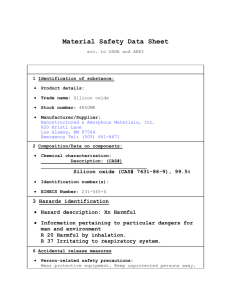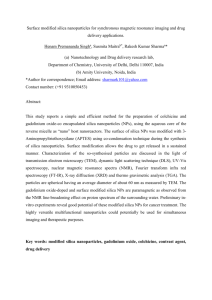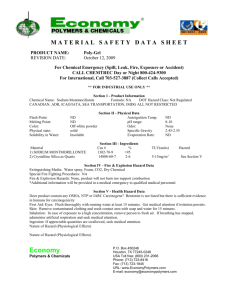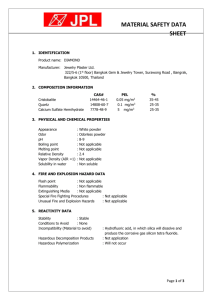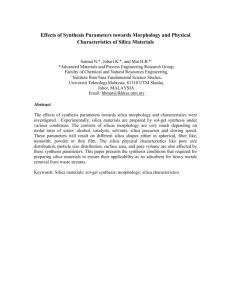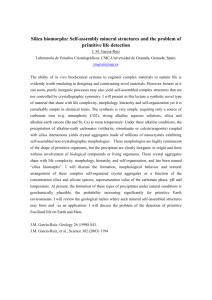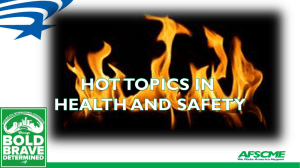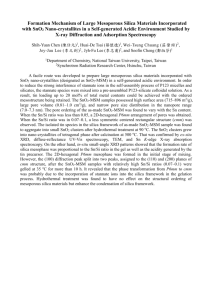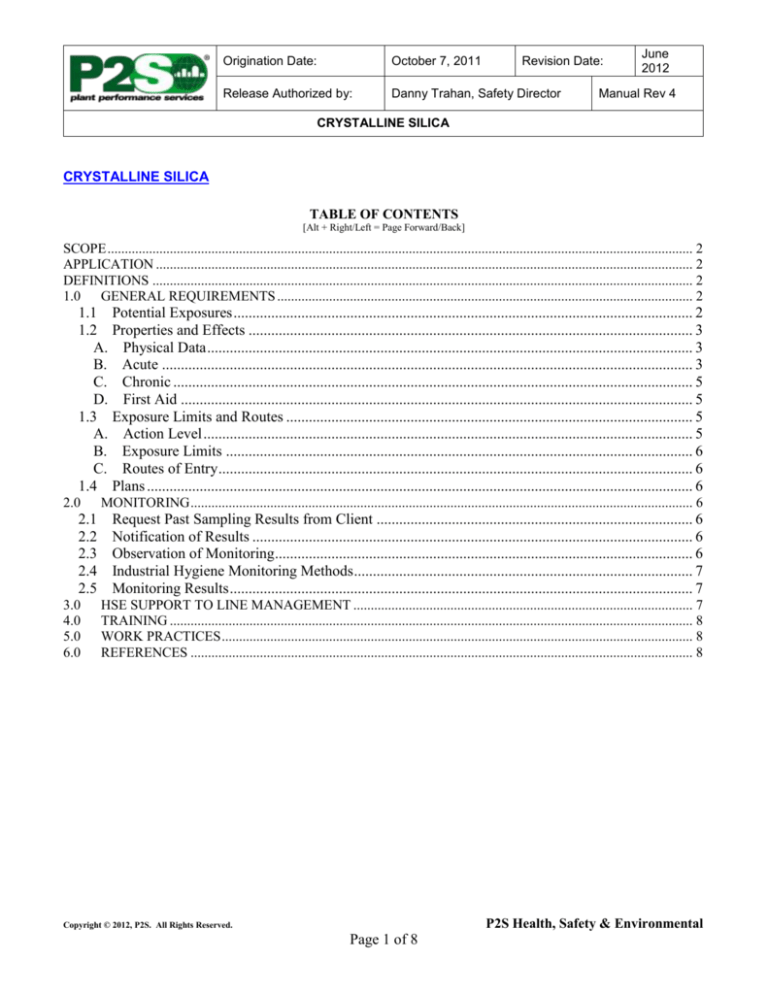
Origination Date:
October 7, 2011
Revision Date:
Release Authorized by:
Danny Trahan, Safety Director
June
2012
Manual Rev 4
CRYSTALLINE SILICA
CRYSTALLINE SILICA
TABLE OF CONTENTS
[Alt + Right/Left = Page Forward/Back]
SCOPE ......................................................................................................................................................................... 2
APPLICATION ........................................................................................................................................................... 2
DEFINITIONS ............................................................................................................................................................ 2
1.0 GENERAL REQUIREMENTS ........................................................................................................................ 2
1.1 Potential Exposures .......................................................................................................................... 2
1.2 Properties and Effects ...................................................................................................................... 3
A. Physical Data ................................................................................................................................. 3
B. Acute ............................................................................................................................................. 3
C. Chronic .......................................................................................................................................... 5
D. First Aid ........................................................................................................................................ 5
1.3 Exposure Limits and Routes ............................................................................................................ 5
A. Action Level .................................................................................................................................. 5
B. Exposure Limits ............................................................................................................................ 6
C. Routes of Entry .............................................................................................................................. 6
1.4 Plans ................................................................................................................................................. 6
2.0
2.1
2.2
2.3
2.4
2.5
3.0
4.0
5.0
6.0
MONITORING ................................................................................................................................................. 6
Request Past Sampling Results from Client .................................................................................... 6
Notification of Results ..................................................................................................................... 6
Observation of Monitoring............................................................................................................... 6
Industrial Hygiene Monitoring Methods .......................................................................................... 7
Monitoring Results ........................................................................................................................... 7
HSE SUPPORT TO LINE MANAGEMENT .................................................................................................. 7
TRAINING ....................................................................................................................................................... 8
WORK PRACTICES ........................................................................................................................................ 8
REFERENCES ................................................................................................................................................. 8
P2S Health, Safety & Environmental
Copyright © 2012, P2S. All Rights Reserved.
Page 1 of 8
Origination Date:
October 7, 2011
Revision Date:
Release Authorized by:
Danny Trahan, Safety Director
June
2012
Manual Rev 4
CRYSTALLINE SILICA
PURPOSE
This practice identifies the requirements for minimizing exposure to silica.
SCOPE
This practice includes the following major sections:
General Requirements
Monitoring
HSE Support to Line Management
Training
Work Practices
APPLICATION
This practice applies to work activities and employees under the control of P2S and its contractors.
DEFINITIONS
Action Level (AL) – Refers to an exposure one half the allowable limit (TLV-TWA).
Respirable Fraction – In an industrial hygiene (IH) sample, refers to those particles between 2 and 5 micrometers
in diameter that are small enough to penetrate the nose and upper respiratory system and be deposited deep into the
lungs. Particles that penetrate deeply into the respiratory system are generally beyond the ability of the body’s
natural clearance mechanisms of cilia and mucous, and are more likely to be retained.
Threshold Limit Value – Time-Weighted Average (TLV-TWA) – The TWA concentration for a conventional
8-hour workday and a 40-hour work week, to which it is believed that nearly all workers may be repeatedly
exposed, day after day, without adverse effect.
Threshold Limit Value – Short-Term Exposure Limit (TLV-STEL) – The concentration to which it is believed
that workers can be exposed continuously for a short period of time without suffering from irritation, chronic or
irreversible tissue damage, or narcosis of sufficient degree to increase the likelihood of accidental injury, impair
self-rescue, or materially reduce work efficiency, and provided that the daily TLV-TWA is not exceeded. A STEL
is a 15-minute TWA exposure that should not be exceeded at any time during a workday even if the 8-hour TWA is
within the TLV-TWA.
General Requirements
Potential Exposures
Work conducted in/around the following industries/activities may result in exposure to employees:
Sand storms (naturally occurring)
Mining (cutting, blasting, or drilling through sandstone and granite)
Foundry work (grinding, moldings, shakeout, core room)
Ceramics, clay, and pottery
P2S Health, Safety & Environmental
Copyright © 2012, P2S. All Rights Reserved.
Page 2 of 8
Origination Date:
October 7, 2011
Revision Date:
Release Authorized by:
Danny Trahan, Safety Director
June
2012
Manual Rev 4
CRYSTALLINE SILICA
Stone cutting (sawing, abrasive blasting, chipping, grinding)
Glass manufacturing
Dirt work or vehicular traffic on dirt roads
Abrasive blasting
Railroad (setting and laying track)
Manufacturing and use of abrasives
Manufacturing of soaps
Demolition, removal, or salvage of structures where materials containing silica are
present
Hand- or machine-mixing materials to create concrete or grout
Construction (sandblasting/rock drilling/masonry work/jack hammering/tunneling)
New construction, alteration, repair, or renovation of structures and substrates
containing silica
The industries/activities listed above are examples. The project HSE Representative will identify the areas or
operations involving the disturbance of silica that are likely to generate visible amounts of silica. The identified
areas or operations will be discussed as part of the new hire orientation, hazard communication, and, if required,
silica exposure training courses for employees.
Additionally, activities conducted using silica/silica-containing products—or that result in visible airborne silica—
will be identified on the Job Safety Analysis (JSA), Form 000.653.F0100, or the Safety Task Analysis (STA), Form
000.653.F0101, with controls established.
Properties and Effects
Silica occurs as a natural component of many materials in the construction and general industry. Crystalline silica
is always present in substantial quantities in sand, sandstone, and granite. Exposure over a long period of time
leads to fibrosis of the lung tissues with a subsequent loss of lung tissue — this is called silicosis. Employees
affected by silicosis usually suffer from shortness of breath and find it difficult to walk short distances on stairs.
Silicosis is incurable. Crystalline silica is a recognized human carcinogen.
Physical Data
Appearance:
Odor:
Odor Threshold:
Explosive Limits:
Melting Point:
Vapor Pressure:
N/A
Ignition Temperature:
Vapor Density:
White powder
None
N/A
N/A
3110 °F (1710 °C)
N/A
Nonflammable
Acute
Irritant:
Sensitization:
Mild
Unlikely
P2S Health, Safety & Environmental
Copyright © 2012, P2S. All Rights Reserved.
Page 3 of 8
Origination Date:
October 7, 2011
Revision Date:
Release Authorized by:
Danny Trahan, Safety Director
June
2012
Manual Rev 4
CRYSTALLINE SILICA
Eye Effects: Low concentrations may cause irritation to the lining of the eye. Repeated exposure to low
concentrations is reported to cause inflammation of the eye tissues, sensitivity to light, tearing, pain, and blurred
vision.
Skin Effects: May irritate sensitive skin.
Ingestion Effects: Ingestion is unlikely.
P2S Health, Safety & Environmental
Copyright © 2012, P2S. All Rights Reserved.
Page 4 of 8
Origination Date:
October 7, 2011
Revision Date:
Release Authorized by:
Danny Trahan, Safety Director
June
2012
Manual Rev 4
CRYSTALLINE SILICA
Inhalation Effects:
An acute form of silicosis has occurred in a few workers exposed to very high concentrations of silica over periods
of as little as a few weeks. The history is one of progressive shortness of breath, fever, cough, and weight loss.
Chronic
Teratogen (may cause birth defects):
Reproductive Hazard:
Mutagen (may cause damage to DNA):
Synergistic Effects
(more toxic when mixed with other chemicals):
Carcinogenicity:
No
No
No
None reported
NTP: Yes
IARC: Yes
OSHA: Yes
Medical Conditions
Aggravated by Exposure:
Respiratory and heart
Chronic silicosis, the most common form of the disease, may go undetected for years in the early stages; in fact, a
chest X-ray may not reveal an abnormality until after 15 or 20-years of exposure. The body’s ability to fight
infections may be overwhelmed by silica dust in lungs, making workers more susceptible to certain illnesses such
as tuberculosis. As silicosis progresses, one or more of the following symptoms may develop:
Shortness of breath following physical exertion
Severe cough
Fatigue
Loss of appetite
Chest pains
Fever
Inhalation of quartz is classified as a human carcinogen.
First Aid
Skin/Eyes: Flush with clean, low-pressure water for 5–15 minutes.
Severe inhalation: Remove from contaminated area immediately. Give oxygen. If not breathing, give artificial
respiration. Do not attempt to rescue unless wearing self-contained breathing apparatus
Exposure Limits and Routes
Action Level
0.015 mg/m3 respirable fraction of crystalline silica.
P2S Health, Safety & Environmental
Copyright © 2012, P2S. All Rights Reserved.
Page 5 of 8
Origination Date:
October 7, 2011
Revision Date:
Release Authorized by:
Danny Trahan, Safety Director
June
2012
Manual Rev 4
CRYSTALLINE SILICA
Exposure Limits
0.025 mg/m3 respirable fraction of crystalline silica (ACGIH TLV).
Routes of Entry
Skin Contact:
Skin Absorption:
Eye Contact:
Inhalation:
Ingestion:
Yes
No
Yes
Yes
Unlikely
Plans
Where exposure limits are likely to be exceeded, a “silica compliance plan” or a JSA must be developed. The plan
will:
Address the scope of work activities.
Provide an initial exposure assessment.
Prescribe exposure controls (such as water sprays, exhaust ventilation, working inside
enclosures with filtered air supplies), air-monitoring requirements, work practices,
dust control measures, personal protective equipment, and additional
information/requirements as appropriate.
Results of air or bulk sampling, calculations of potential silica exposure, and other data that demonstrate
compliance with this practice are attached to the plan/JSA.
MONITORING
Request Past Sampling Results from Client
Before working in operating facilities or areas with known sources of silica, each project will formally request
information from the client on past IH, air quality, or other sample results that may be used to indicate the levels of
exposure likely to be encountered by P2S and contractor employees. This request will be in writing and
documented in accordance with the project’s document control procedures. The written request and any response
will become part of the project records and will be retained in accordance with Practice 000.653.1500, Records
Management and Document Control.
Notification of Results
Notification of monitoring results will be in accordance with Practice 000.653.2007, Hazard Communications.
Observation of Monitoring
The monitoring process may be observed by employees whom the monitoring affects.
P2S Health, Safety & Environmental
Copyright © 2012, P2S. All Rights Reserved.
Page 6 of 8
Origination Date:
October 7, 2011
Revision Date:
Release Authorized by:
Danny Trahan, Safety Director
June
2012
Manual Rev 4
CRYSTALLINE SILICA
Industrial Hygiene Monitoring Methods
The common IH monitoring methods for silica are NIOSH laboratory analysis methods (as appropriate) 7500,
7501, 7601, 7602, and 7603 (http://www.cdc.gov/niosh/nmam/pdfs/7500.pdf)
Monitoring Results
Monitoring results will be sent to the Corporate IH Manager in accordance with the schedule in Practice
000.653.2000, Industrial Hygiene Program Requirements.
HSE SUPPORT TO LINE MANAGEMENT
The HSE Representative, with support from the Corporate IH Manager, will perform the following:
As part of the JSA and other hazard evaluation processes, identify and evaluate
crystalline silica hazards and potential exposures during the planning and conduct of
work.
Review and approve the silica compliance plan or JSA.
As necessary, quantitatively determine the presence of silica in materials, substrates,
and other media. This may involve review of material safety data sheets (MSDS), or
the collection of samples (bulk and/or airborne) for analysis by a qualified laboratory.
Provide results of silica survey to management/supervision, along with information
regarding hazard potential and control measures. As appropriate, make
recommendations to management/supervision to maintain, modify, upgrade, or
downgrade controls accordingly.
Take prompt corrective measures to eliminate hazards; such as recommending to
management/supervision to implement or modify engineering, administrative, work
practice, and personal protection (including respiratory protection) controls.
Conduct an exposure assessment, as appropriate.
In evaluating silica hazards and specifying controls for an operation, (a) use the best
available historical exposure monitoring data generated for other similar operations or
activities, (b) use objective data, and/or (c) plan and conduct initial monitoring to
determine exposures and assess the effectiveness of hazard controls.
Determine exposure to crystalline silica periodically as work is conducted.
Maintain effective records of jobs monitored, so that a historical database can be used
to specify controls and eliminate unnecessary and redundant monitoring for future
activities.
Support project management/supervision in responding to exposures above allowable
limits when workers were not adequately protected.
As appropriate, participate in pre-job and daily worker briefings regarding taskspecific crystalline silica hazards and controls, the silica compliance plan/JSA, work
practices, and other applicable information, including any changes that are made to
controls or to the silica compliance plan/JSA.
P2S Health, Safety & Environmental
Copyright © 2012, P2S. All Rights Reserved.
Page 7 of 8
Origination Date:
October 7, 2011
Revision Date:
Release Authorized by:
Danny Trahan, Safety Director
June
2012
Manual Rev 4
CRYSTALLINE SILICA
TRAINING
Training will be conducted in accordance with Practice 000.653.2007, Hazard Communication, for employees who
will or may be exposed to silica at/above the AL on any day.
WORK PRACTICES
The following work practices will be implemented whenever activities that disturb materials containing more than
0.1 percent crystalline silica by weight are conducted:
A JSA will be developed in accordance with Practice 000.653.1304, Pre-Task
Planning/Risk Analysis, to determine and document in writing those exposure control
measures determined to be needed. The JSA must be maintained with the project
records in accordance with Practice 000.653.1500, Records Management and
Document Control.
Exposed surfaces will be maintained as free as practicable of silica-containing dust.
Surfaces will not be blow-cleaned with compressed air or other forced air (such as leaf
blowers).
Wet sweeping or vacuuming will be used to clean areas. If vacuuming is used for
cleaning, the exhaust air will be properly filtered to prevent release of airborne silica
back into the workroom – such as by using a HEPA-filtered vacuum.
Clothes contaminated with silica will not be blown or shaken to remove dust.
Carcinogen warnings will be placed on containers of materials containing more than
0.1 percent crystalline silica by weight. An intact pallet load of bricks while still
banded or packaged as it was received is considered a container.
P2S- or contractor-owned/operated vehicles hauling shipments of crushed stone off
site must include hazard warnings concerning the carcinogenicity of crystalline silica
on their shipping papers or bills of lading.
REFERENCES
Document ID
Document Title
000.653.1304
Pre-Task Planning/Risk Analysis
000.653.1500
Records Management and Document Control
000.653.2000
Industrial Hygiene Program Requirements
Forms:
000.653.F0100
Job Safety Analysis
000.653.F0101
Safety Task Assignment
P2S Health, Safety & Environmental
Copyright © 2012, P2S. All Rights Reserved.
Page 8 of 8

